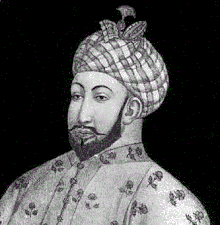Muhammad Khwaja
The Hazāra of Muḥammad Khwāja (Hazaragi: هزارهٔ محمد خواجه) is one of tribes of the ethnic Hazara inhabiting in Afghanistan.[1]
| Hazāra of Muḥammad Khwāja هزارهٔ محمد خواجه Muhammad Khwaja | |
|---|---|
 Emir Muhammad Khwaja miniature | |
| Ethnicity | Hazara |
| Location | Currently Afghanistan Previously Central Asia (Uzbekistan), Hindustan |
| Descended from | Barlas |
| Religion | Islam |
| Part of a series on |
| Hazara people |
|---|
 |
|
About · The people · The land · Language · Culture · Diaspora · Persecutions · Tribes · Cuisine Politics · Writers · Poets · Military · Religion · Sports · Battles |
Emir Muhammad khwaja belong to Barlas tribe. He is son of Emir Haji Saifuddin also spelled as Seifedin [2] who was Vizier of Timur in the beginning and later became Governor of Qandahar province now in Afghanistan. His great-grandfather, Hajji Beg Barlas, was leader of Barlas tribe who overthrown Qara'unas Abdullah from power in southern Chagatai Khanate. Abdullah, who had recently taken power, was young and inexperienced, and his move to Samarkand threatened Hajji Beg, whose territories were centered in the nearby city of Kish.
Emir, Khan, Mirza, Baig, Shah, Ghazi, and Sultan are titles to his tribes and descendants to date. But Emir and Mirza are titles specific to his family.
Emir Muhammad Khwaja was the commander in chief of Babur’s army. He is well known as Khwaja e Bozorg ‘the great khwaja’. His names appears in many historical script including Babur Nama.
Emir was a great writer and calligrapher. This talent has also been depicted by many of his descendants in different era such as Faiz Mohammad Katib Hazara who served as Afghan court chronicler and secretary to Emir Habib Ullah Khan from 1901 to 1919.[3]
Emir Muhammad Khwaja served as chief of army of Babur during his struggle to capture Delhi in each battle including the last one in Panipat. Emir admired the continental weather in central Asia and could never adjust to the hot weather of Delhi. It has been recorded that Emir Khwaja lived in Sharan district of Paktia province and many of his descendants scattered from there to other parts of Afghanistan. Emir Khawja is buried in Sharan District of Paktia Province in Afghanistan.
Emir Muhammad khwaja had three sons Emir Wali, Emir Babuk, and Emir Bahlool.
List of Notable Hazara of Muhammad Khwaja
- Faiz Mohammad Katib Hazara
- Dr. Abdul Wahid Sarabi
- Habiba Sarabi
- Ramazan Bashardost
- Sardar Muhammad Azim Khan
See also
- Hazara tribes
- Hazara people
References
- Hassan Poladi. The Hazāras. Mughal Pub. Co., 1989. ISBN 0-929824-00-8, ISBN 978-0-929824-00-0.
- Page 478, Book III , The History of Timur-Bec, by Sharaf al-din Ali Yazdi
- Kitab-e Tadakkor-e Enqilab, Translation: Shkirando as "Kniga Upominanii o Myatezhe" Moscow, 1988. p. 20